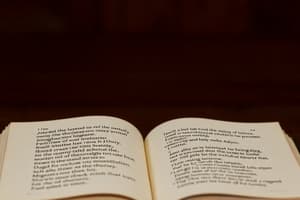Podcast
Questions and Answers
Flashcards
Phonetic phenomena
Phonetic phenomena
such as stress, intonation, syllable length, and pause (including caesura) influence rhythm. The arrangement of these elements within a line determines its overall rhythm.
rhyme
rhyme
Rhyme is the repetition of similar sounds, usually at the ends of lines in poetry
types of rhyme
types of rhyme
a. Perfect rhyme (e.g., "bat" and "hat") b. Slant rhyme (also called near rhyme, e.g., "worm" and "swarm") c. Internal rhyme (when a rhyme occurs within a line of poetry) d. End rhyme (when rhyming words occur at the ends of lines)
Alliteration
Alliteration
Signup and view all the flashcards
Assonance
Assonance
Signup and view all the flashcards
Consonance
Consonance
Signup and view all the flashcards
stanza
stanza
Signup and view all the flashcards
sonnet
sonnet
Signup and view all the flashcards
• Shakespearean (or English) Sonnet
• Shakespearean (or English) Sonnet
Signup and view all the flashcards
• Petrarchan (or Italian) Sonnet
• Petrarchan (or Italian) Sonnet
Signup and view all the flashcards
END-STOPPED LINE
END-STOPPED LINE
Signup and view all the flashcards
Run-on line (enjambment)
Run-on line (enjambment)
Signup and view all the flashcards
CAESURA
CAESURA
Signup and view all the flashcards
ELISION
ELISION
Signup and view all the flashcards
EXPANSION
EXPANSION
Signup and view all the flashcards
ONOMATOPOEIA
ONOMATOPOEIA
Signup and view all the flashcards
Rhythm
Rhythm
Signup and view all the flashcards



